Reserve Bank of Australia Annual Report – 2010 Currency
The Reserve Bank is responsible for the production and issuance of new banknotes and the destruction of unfit banknotes. The ultimate goal is to preserve public confidence in the currency, such that banknotes continue to be an effective payment mechanism and a secure store of wealth. This confidence is maintained by:
- ensuring there are sufficient banknotes available to meet public demand;
- keeping a high quality of banknotes in circulation; and
- conducting research to ensure that the currency remains secure against counterfeiting.
Note Issue Department is responsible for ensuring the supply of quality banknotes and researching security features to be incorporated on banknotes. The Assistant Governor (Currency) also chairs the boards of Note Printing Australia Limited (NPA), the Reserve Bank's wholly owned subsidiary that prints Australia's banknotes, and Securency International Pty Ltd, the joint venture company that produces the polymer substrate used for Australia's banknotes.
New Banknote Purchases
The Reserve Bank purchased 170 million banknotes from NPA in 2009/10, 104 million fewer banknotes than were purchased in the previous year. The order consisted of 31 million $20 banknotes, 111 million $50 banknotes and 29 million $100 banknotes. No $5 or $10 banknotes were printed as the Reserve Bank had sufficient stock of these denominations to meet public demand. The lower number of banknotes purchased in 2009/10 than in recent years reflected a slowing in the growth of demand for new banknotes since the start of 2009, but was around the average number of banknotes purchased each year since the polymer series was introduced in the mid 1990s.
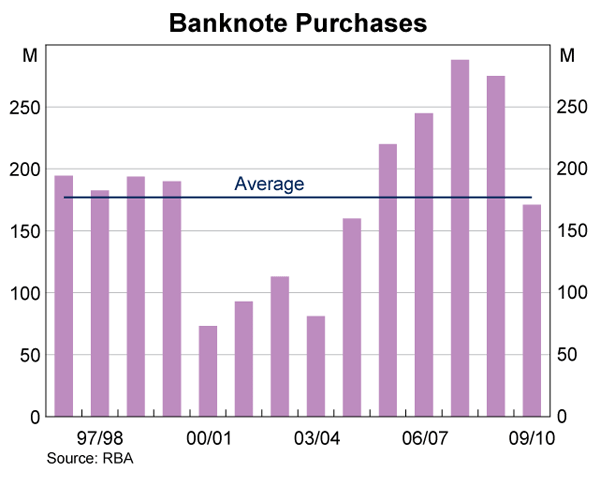
Banknotes on Issue
At the end of June 2010 there were around 1 billion banknotes on issue, worth approximately $48.8 billion. This represents an increase of 1.4 per cent over the year, following a rise of 14.3 per cent over the previous year.
Towards the end of 2008 there was a sharp increase in the demand for banknotes in line with the public's concerns associated with the global financial crisis. Demand abated considerably as those concerns diminished over the course of 2009. Considering these two periods together, the average annual growth in the value of banknotes on issue during this episode was around 8 per cent, broadly comparable to the average over the past 15 years of 7 per cent.
The stock of banknotes on issue is equivalent to 47 banknotes worth $2,180 for every Australian, a marginal decline from the previous year. The $50 banknote accounted for half the value of banknotes on issue and 45 per cent of the number of banknotes on issue, while the $100 banknote accounted for around 43 per cent of the value and 20 per cent of the number.
| At end June | $5 | $10 | $20 | $50 | $100 | Total |
Increase
(percentage change) |
|---|---|---|---|---|---|---|---|
| 2004 | 533 | 791 | 2,533 | 15,941 | 14,224 | 34,022 | 5.7 |
| 2005 | 539 | 837 | 2,584 | 16,740 | 14,924 | 35,624 | 4.7 |
| 2006 | 572 | 857 | 2,690 | 18,044 | 15,903 | 38,066 | 6.9 |
| 2007 | 591 | 894 | 2,846 | 19,228 | 16,730 | 40,289 | 5.8 |
| 2008 | 614 | 917 | 2,732 | 20,111 | 17,690 | 42,064 | 4.4 |
| 2009 | 644 | 954 | 2,651 | 23,721 | 20,117 | 48,087 | 14.3 |
| 2010 | 673 | 983 | 2,653 | 23,711 | 20,740 | 48,760 | 1.4 |
|
Source: RBA |
|||||||
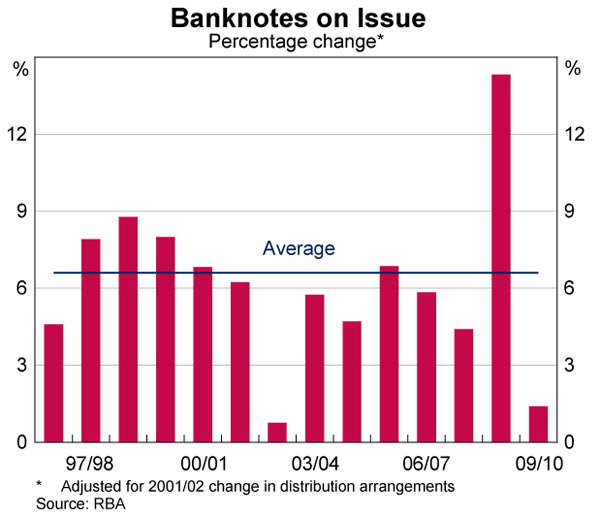
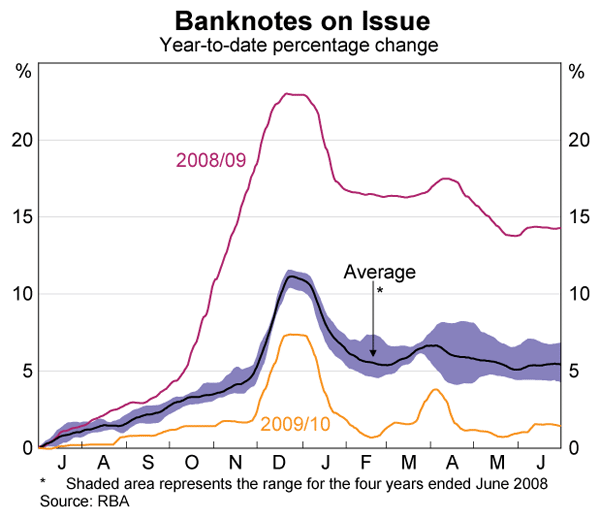
Distribution
In addition to banknotes on issue, the Reserve Bank maintains a contingency holding of banknotes. The purpose of this holding is to meet normal seasonal fluctuations in demand as well as to mitigate the risks associated with financial shocks and production disruptions.
Commercial banks also maintain surplus banknote stocks in approved cash centres located throughout Australia. These stocks ensure there are sufficient banknotes to meet customers' daily currency requirements. Commercial banks are encouraged to replenish these stocks by dealing directly with each other, but have the option of sourcing new banknotes from the Reserve Bank when required. For the past decade, new banknotes have been issued by the Bank from the National Note Processing and Distribution Centre (NNPDC), located within NPA at Craigieburn, Victoria. Following the increase in demand in 2008, a second distribution point was opened at the Bank's Head Office in Sydney in late 2009. This has provided commercial banks with more flexible access to the Reserve Bank's contingency holdings, and has significantly enhanced the Bank's ability to respond to changes in the demand for banknotes.
Banknote Quality
In order to maintain a high quality of banknotes in circulation, the Reserve Bank regularly issues new banknotes and withdraws unfit banknotes. These activities ensure the efficient handling of banknotes by the public and processing through the banknote evaluation machines (for example, ticketing machines) that are increasingly present in the community. High-quality banknotes also enable the public to detect counterfeits more easily.
The commercial banks and armoured car companies play an important role in achieving the Reserve Bank's quality objective. The Bank provides incentives for commercial banks and armoured car companies to sort unfit banknotes from their holdings and to invest in banknote examination technologies. Banknotes deemed to be unfit by the commercial banks and armoured car companies are returned to the NNPDC, where they are processed to confirm their quality and authenticity. Returned banknotes that are verified as being fit by the NNPDC are reissued, while those determined to be unfit are destroyed. Of the 104 million banknotes returned to the NNPDC during 2009/10, 92 million were destroyed.
Some banknotes are damaged in circulation beyond the normal levels of wear and tear, becoming unsuitable for processing through high-speed sorting equipment. The Reserve Bank has a policy of paying value for severely damaged banknotes that can be authenticated as genuine Australian banknotes. This includes banknotes significantly damaged or contaminated as a result of natural disasters.
Although commercial banks can assess damaged banknotes and pay the assessed value for them, all damaged banknotes are returned to the Reserve Bank for final assessment and destruction. Under this arrangement, most damaged banknotes receive full value. Where a large piece of a banknote is missing, however, only the appropriate partial value is paid. During 2009/10, the Bank assessed around 19,400 damaged banknote claims, and paid out around $6.7 million.
Counterfeiting in Australia
Australia's level of counterfeiting continues to remain low in comparison with most other countries. In 2009/10, a total of 7,836 counterfeits were detected, with a nominal value of $413,995. This corresponds to around seven counterfeits passed per million genuine banknotes in circulation, a small decline from 2008/09 and around the average over recent years. As in previous years, the $50 note was the most commonly counterfeited denomination, accounting for 88 per cent of the counterfeits passed in 2009/10.
| $5 | $10 | $20 | $50 | $100 | Total | |
|---|---|---|---|---|---|---|
| Number | 35 | 107 | 170 | 6,861 | 663 | 7,836 |
| Nominal value ($) | 175 | 1,070 | 3,400 | 343,050 | 66,300 | 413,995 |
| Parts per million | 0.3 | 1.1 | 1.2 | 14.3 | 3.2 | 7.4 |
|
Source: RBA |
||||||
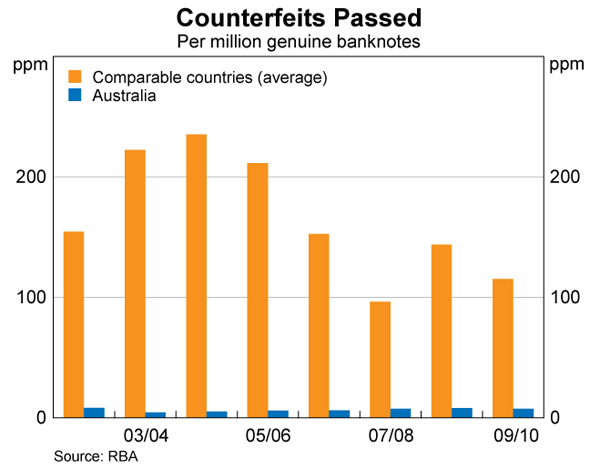
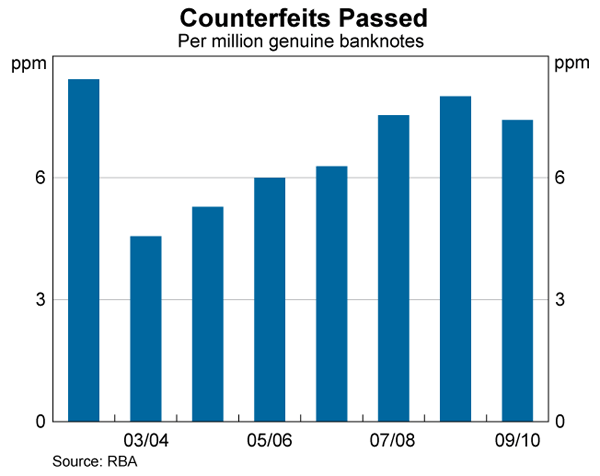
Consistent with the objective of maintaining confidence in Australia's banknotes, the Reserve Bank is committed to ensuring counterfeiting activity in Australia remains as low as possible. Reflecting this objective, the Bank is actively involved in a number of initiatives, including:
- working with law enforcement agencies in Australia and overseas, as well as other central banks, to monitor trends in counterfeiting;
- maintaining a dedicated Counterfeit Examination Laboratory to assist the Australian Federal Police with counterfeit handling by providing law enforcement with expert witness statements and court testimonies as required; and
- educating the public and domestic law enforcement agencies about how to identify counterfeits and what actions should be taken when counterfeits are identified. In addition to improving the accessibility of this information on the Reserve Bank's website, a number of counterfeit information sessions were conducted with State Police in New South Wales, South Australia and Queensland during the year.
Banknote Research and Development
The Reserve Bank maintains an active research and development program in order to develop security features that are more difficult to counterfeit but which are functional for a wide variety of users. As part of this program, the Bank works co-operatively with a range of third parties, including private companies, research institutions and universities. The Bank also shares information with other central banks on counterfeit deterrence issues and solutions.
In 2009/10, the Reserve Bank continued its involvement in two major international initiatives related to the combat of counterfeiting: the Central Bank Counterfeit Deterrence Group, a working group of central banks and banknote printing authorities that monitors threats posed by emerging counterfeiting technologies and proposes solutions for implementation by issuing authorities; and the Reproduction Research Centre, an anti-counterfeiting testing facility operated by a small number of central banks.
Numismatic Banknote Sales
The Reserve Bank conducted two auctions of banknotes of numismatic interest in 2007 and 2008. Notwithstanding the success of these auctions, the Bank considered a number of alternative models. As a result of this review, it was decided that numismatic banknotes that were produced in the previous year would be sold to the public at fixed prices during a pre-defined sales period.
The sale of these numismatic banknotes, of all the denominations produced in 2008, was conducted over a six-week period from September 2009. In May 2010, a similar sale was conducted for banknotes produced in 2009. In both cases, public participation in the process was high.
Note Printing Australia
Note Printing Australia (NPA) is a wholly owned subsidiary of the Reserve Bank, which produces Australia's banknotes and operates the NNPDC on behalf of the Bank. NPA's charter states that its prime focus is on the efficient production of Australia's banknotes to a high quality, consistent with specifications determined by the Bank's Note Issue Department. In addition to these core activities, NPA also produces Australia's passports for the Department of Foreign Affairs and Trade, banknotes for some other countries in the Asia-Pacific region, and banknote security materials for a number of countries.
NPA is governed by a board of four directors appointed by the Reserve Bank. The Board at present comprises four serving Bank executives: Bob Rankin, Assistant Governor (Business Services) as Chairman; Keith Hall, Assistant Governor (Banking & Payments); Darryl Ross, Chief Financial Officer; and Lindsay Boulton, Head of Risk Management. The Chief Executive is Bernhard Imbach, who was appointed to this position in 2008.
In 2009/10, NPA delivered 170 million banknotes for Australia and 275 million banknotes for other countries, specifically Chile, Malaysia, New Zealand, Papua New Guinea and Singapore. NPA also produced 2.0 million Australian passports during the year.
NPA earned a profit after tax of $4.3 million in 2009/10, compared with a profit of $6.1 million in the previous year. The financial accounts for NPA are consolidated with those of the Reserve Bank.
Securency
Securency is a joint venture between the Reserve Bank and Innovia Films, a leading manufacturer of polypropylene films based in the United Kingdom. Securency produces Guardian® banknote substrate for Australia and a number of other countries; this substrate is based on a specialised film manufactured by Innovia.
Securency is governed by a board comprising eight voting directors, of which the Reserve Bank and Innovia each appoint four. The directors appointed by the Bank are Bob Rankin (Chairman), John Akehurst (a non-executive member of the Reserve Bank Board), Darryl Ross and Les Austin. Securency is based in Craigieburn, Victoria.
Securency manufactures substrate at factories in Craigieburn and in Queretaro, Mexico. The latter is operated by Securency Mexico, S.A. DE C.V., a joint venture between Securency and the Banco de Mexico. During 2009/10, Securency manufactured substrate for 12 countries: Australia, Chile, Costa Rica, Guatemala, Honduras, Mexico, Nigeria, Papua New Guinea, Paraguay, Romania, Singapore and Vietnam. In May 2010, Securency launched a new optically variable feature, Latitude™, the first of a range of banknote security features based on a newly developed proprietary manufacturing platform.
Securency earned a profit after tax of $24.1 million in 2009, sharply higher than the profit of $7.9 million in the previous year. The rise reflected an increase in demand for substrate by customers in Africa and Latin America. Sales in 2009 were $172 million, up from $119 million the year before. The Reserve Bank equity accounts for its investment in Securency.
In mid 2009, following media allegations of possible corruption involving Securency's agents in overseas territories, the Board of Securency referred the allegations to the Australian Federal Police for independent investigation. The Board also commissioned a review by KPMG of the company's policies and procedures relating to the use of agents. KPMG's report was completed, and released by Securency, in March 2010. The review found that the Board of Securency had established policies that should have been adequate in managing or mitigating risks associated with the use of agents, but that these policies had not been fully implemented. KPMG made 12 recommendations to strengthen policies and procedures, which the Board accepted and committed to implement. The investigation by the Australian Federal Police is continuing. The Board of Securency has kept the Reserve Bank and Innovia fully informed of its actions and decisions.